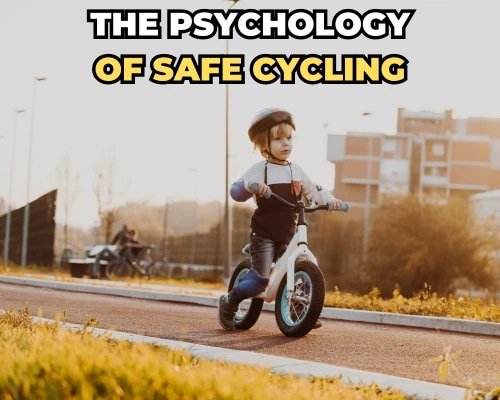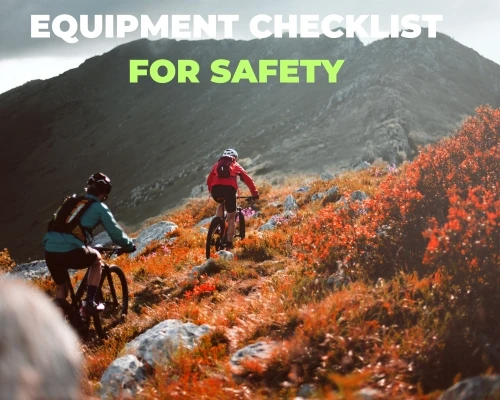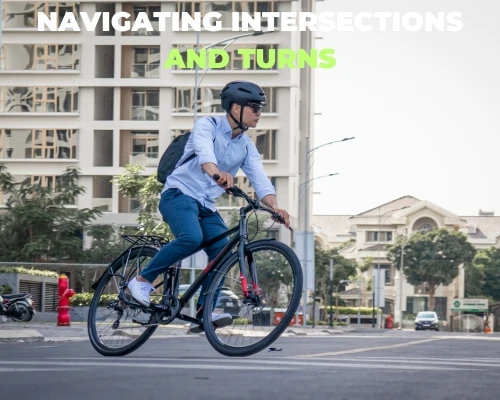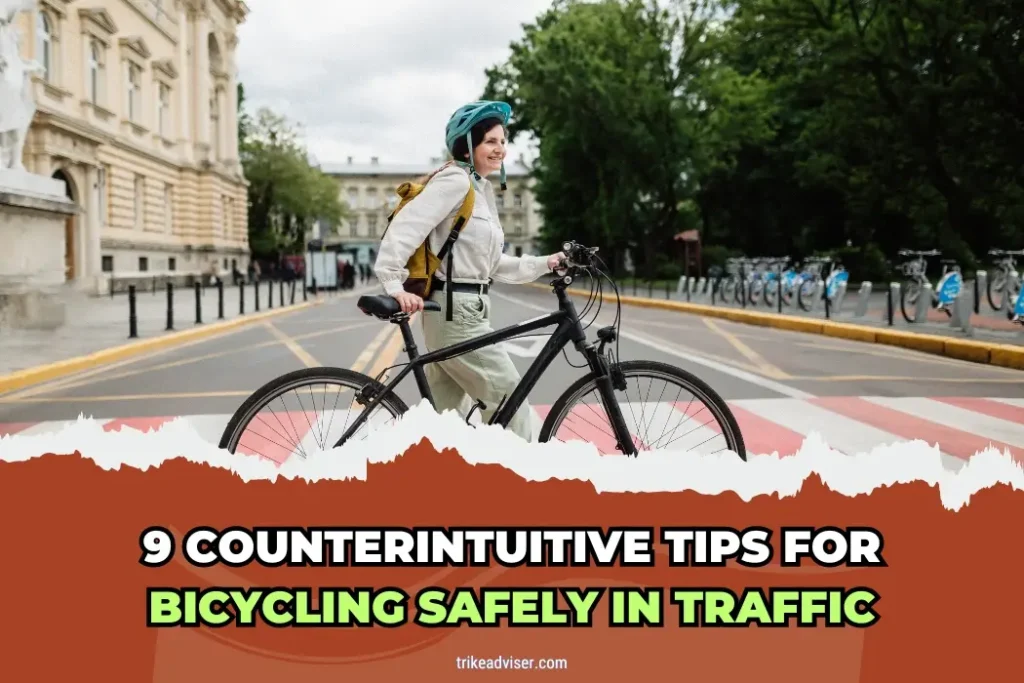Bicycling in traffic seems daunting, doesn’t it?
Most advice out there starts sounding the same. Wear a helmet. Use lights. Yet, accidents happen. Cyclists and cars clash. Why? Standard tips only scratch the surface.
They don’t tackle the real fear of mingling with rush-hour traffic. Or the unpredictability of city streets.
Enter the counterintuitive. The not-so-obvious. Safety tips that might just save your life, or at least prevent a few scrapes.
These tips aren’t your usual cycling safety lecture. They’re born from the streets. From real rides. From close calls.
Think you know how to navigate city traffic on two wheels? Let’s test that. It’s about being smart, not just visible. Ready to see the city streets in a new light?
9 Counterintuitive Tips for Bicycling Safely In Traffic
Ride Predictably
Predictability is your shield in traffic. Drivers can’t read minds. They react to what they see. So, ride straight. Signal your turns early. Keep your speed steady. This way, cars know your next move. It’s basic, yet vital. Predictability equals visibility equals safety.
Hold Your Line
Straight lines aren’t just for art class. They’re your path through traffic. Whether you’re changing lanes or turning, keep it straight. This clarity is your communication with drivers. It says, “I know where I’m going, and you should too.”
Be Assertive
Timidity loses in the traffic game. Hugging the curb might seem safe. It’s not. It makes you invisible. And vulnerable. Claim your space. Ride with purpose. A visible cyclist is a respected one. It’s not about aggression. It’s about presence.
Anticipate Driver Behavior
Think like a chess player. Stay three moves ahead. Drivers can be unpredictable. But often, patterns emerge. Turning vehicles. Lane changers. Parking exits. Read the road. Predict. Prepare. It’s your safety net.
Use Eye Contact
Eyes are powerful. They communicate. In the traffic dance, eye contact is your connection. Make sure drivers see you. It’s a silent agreement. “I see you, you see me. Let’s keep it safe.” It works.
Wear Bright Clothing and Use Lights
Visibility is your armor. Bright clothing is your flag by day. Lights and reflectors, your beacon by night. It’s simple. Seen cyclists are safe cyclists. This isn’t the time for fashion subtlety. Shine bright.
Ride Defensively
Assume invisibility. It’s harsh but safe. Don’t trust glances. Be ready to act. Evasive maneuvers. Quick stops. Your awareness is your radar. Detect threats before they’re threats. This is defensive riding. It saves lives.
Choose Safer Routes
Not all roads are equal. Some are battlefields. Avoid them. Seek out the calm. Bike lanes. Bike paths. Quieter streets. These are your sanctuaries. Safety isn’t just about how you ride. It’s also where.
Take a Course
Knowledge is power. A cycling safety course? That’s your power-up. Cycling Savvy offers wisdom. Online. Accessible. It’s more than riding. It’s navigating the chaos. With confidence. With skill. Equip yourself. It’s worth it.
The Psychology of Safe Cycling

Navigating the bustling streets requires more than just physical agility; it’s a mental game. The psychology of safe cycling is twofold, focusing on understanding both the driver’s mindset and fortifying the cyclist’s own mental approach.
Understanding Driver Behavior
Drivers May Not Always See Cyclists
Visibility is a constant challenge. Many drivers aren’t actively looking for cyclists, leading to close calls. Recognizing this can help cyclists stay alert and proactive in making themselves seen.
Eye Contact and Body Language
A glance can convey much. Eye contact with drivers can affirm your presence. Likewise, assertive body language, like a hand signal, communicates your intentions clearly, reducing misunderstandings.
Anticipating Driver Actions
Predicting a car’s next move is crucial, especially at intersections or during lane changes. Observing turn signals, wheel movement, and driver’s head direction can give clues to their next action, allowing cyclists to prepare or reposition.
Building a Cyclist’s Mindset
Ride Predictably and Assertively
Predictability and assertiveness are pillars of safe cycling. Ride in a manner that drivers expect and can easily understand. Signal turns, maintain a straight line, and don’t shy away from taking your lane when necessary.
Confidence, Alertness, and Assertiveness
These three traits form the cyclist’s armor. Confidence in your right to the road, alertness to react to sudden changes, and assertiveness in your actions can significantly enhance safety. They ensure you’re respected on the road.
Choosing Safer Routes
Safer routes are not just about comfort; they’re a strategic choice for minimizing risks. Opting for roads with less traffic and lower speeds, or utilizing bike lanes where available, can dramatically reduce the potential for conflicts.
Quick Tips for Enhancing the Cyclist’s Mindset
- Practice Makes Perfect: Regularly riding in traffic boosts confidence and skill.
- Knowledge is Power: Understanding local traffic laws and cyclist rights can empower you to make safer choices.
- Stay Informed: Keeping up with the latest in cycling safety gear and techniques can provide an edge in urban cycling.
Equipment Checklist for Safety

Every ride starts with preparation. The right equipment isn’t just about convenience; it’s a layer of protection in the bustling urban landscape. From the basics to advanced gear, here’s what every cyclist needs for safer travel.
Essential Safety Gear Every Cyclist Should Have
Helmet
A no-brainer, literally. A helmet with a solid safety rating is your first line of defense. In an accident, it’s often the difference between a scare and a hospital visit. Make sure it fits snugly and is always fastened.
Bright Clothing
Visibility is your best friend. Bright clothing by day and reflective gear by night catch drivers’ eyes. It’s your statement in the sea of traffic: “Here I am!”
Lights
Mandatory after dusk, but a bright idea always. A white light at the front and a red one at the back make you visible from all angles. Even in daylight, blinking lights can help you stand out.
Safety Gear Carriage
How you carry your essentials matters. A backpack or bike-mounted options keep your hands free and your gear clear of the bike chain. Safety is in the details.
Properly Fitted Bike
The right fit isn’t just about comfort; it’s about control. A bike tailored to your size, with brakes that respond and tires that grip, keeps you in command.
Advanced Equipment for Enhanced Visibility and Protection
Backup Light
A second light at the rear boosts your visibility. It’s a simple addition that says, “Notice me,” louder. Especially crucial in dim conditions or crowded streets.
Bike Mirror
Keep an eye on what’s behind without losing focus on what’s ahead. A bike mirror offers a full view without the neck twist. It’s foresight and hindsight together.
Bike Horn or Bell
Sound your presence. A horn or bell cuts through the urban din, alerting others to your space on the road. It’s not just courteous; it’s a safety must.
Bike Computer
Knowledge is power. Speed, distance, route: a bike computer gives you real-time data to navigate smarter. It’s the difference between guessing and knowing, between reacting and planning.
Panniers or Saddlebags
Balance matters. Carry your gear in panniers or saddlebags for stability. They free your back, distribute weight evenly, and keep your essentials handy without sacrificing safety.
Navigating Intersections and Turns

Intersections are the crossroads of conflict for cyclists and drivers alike. Mastering them, and the turns that come with them, is key to a safer ride. Here’s how to navigate these challenges with confidence.
Crossing Intersections Safely
Use Your Turn Signal
Your hands are your blinkers. Signal your intentions clearly and early. It’s the universal language of the roads.
Positioning is Key
Be in the correct lane for your turn, just like a car. This reduces confusion and increases your visibility.
Slow Down
Approach with caution. Speeding through an intersection is a gamble with your safety.
Scan Thoroughly
Look in all directions. Traffic can come from anywhere. Be especially watchful of the cross street.
Prioritize Pedestrians
They have the right of way. Always. No exceptions at crosswalks and intersections, marked or not.
Choose Your Lane Wisely
Turn into the lane that matches your direction. Follow the signs and markings. They’re there for a reason.
Signalized Intersections
Whenever possible, opt for these. A green left-turn arrow means go with protection.
Right Over Left
On city streets, consider right turns over left. It can minimize crossing paths with cars.
Making Safe and Visible Turns
Hand Signals
Communicate with drivers using hand signals. Make sure they’re unambiguous and made in advance.
Proper Lane Usage
Align yourself in the turning lane early. This informs drivers of your intentions and prepares you for the turn.
Check Your Six
Before turning, look back. Ensure traffic has seen your signal and is yielding.
Use a Mirror
A quick glance in a bike mirror keeps you aware of what’s behind without losing focus ahead.
Tech for Visibility
Devices like Garmin Varia alert you and drivers to your presence and intentions. It’s tech support for safety.
Maintain Your Line
Be predictable when turning. A stable, straight line through the turn avoids surprises for everyone involved.
Weather Conditions and Cycling Safety
Weather shapes the canvas of our rides. It brings beauty but also challenges. Adapting to these conditions means changing our approach to ensure both safety and enjoyment. Here’s how to tackle the elements, from rain to shine.
Rain and Wet Conditions
Gear Up
Waterproof attire is your first defense. Jackets, pants, shoe covers keep you dry and comfortable.
Bike Prep
Fenders and mudguards are a must. They shield you from splashes, keeping your vision clear.
Be Visible
Bright lights, reflective clothing. They’re vital in rain’s gloom.
Ride Carefully
Brake early. Avoid quick turns. Wet roads are slick, especially on markings and metal.
Cold Weather
Layer Up
Start with moisture-wicking base layers. Add insulation. Finish with a windproof shell.
Protect Extremities
Thermal gloves, thick socks, shoe covers, and headwear keep the cold at bay.
Warm-Up
Extra time warming up prevents injuries. Cold muscles are more prone to harm.
Stay Warm
Layers are your friend. They trap heat, preventing hypothermia.
Windy Weather
Steady As You Go
A firm grip and a straight line help against gusts.
Adjust Speed
Slower against headwinds. It conserves energy.
Plan Your Route
Face the wind early. Let it push you home.
Watch for Debris
Winds whip up unexpected obstacles. Stay alert.
Foggy Weather
Light Up
Bright, even fog lights are crucial. They cut through the mist.
Slow Down
Reduced speed matches reduced visibility. Safety first.
Sunny and Hot Weather
Hydrate
Water is essential. Drink before you’re thirsty.
Protect Your Skin
Sun cream blocks harmful rays.
Dress Right
Lightweight, moisture-wicking fabrics help you stay cool.
Time It Right
Early mornings, late evenings offer respite from the heat.
Protecting Yourself and Your Bike from the Elements
Clean Your Bike
Regular wipe-downs prevent buildup. A wet lube for the chain combats moisture.
Store It Safely
Indoors is best. Undercover works too. Keep it dry.
Check Tire Pressure
Cold affects pressure. Regular checks keep your ride smooth.
Opt for Wider Tires
More surface area equals more grip. Studded tires for ice are wise choices.
Illuminate Your Path
Lights are essential, not just at night. They make you seen in any weather.
As an Amazon Associate, I earn from qualifying purchases, at no additional cost to you. Read Our Affiliate Disclosure.


